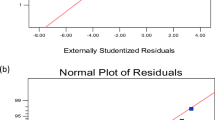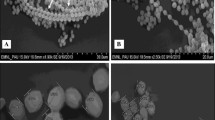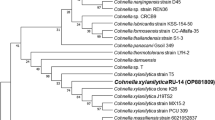Abstract
The utilization of abundantly available lignocellulosic biomass requires an efficient cellulolytic enzyme system. Evaluation of an efficient microbial system is a crucial part for the development of useful enzyme production in an industrial process. The present study reports the production of cellulolytic enzymes from various lignocellulosic biomasses by Trichoderma harzianum strain HZN11 characterized by 18S rDNA sequencing. The organism revealed a well-balanced cellulolytic complex of enzyme production (endoglucanase 30.32 U g−1, exoglucanase 15.08 U g−1, FPase 5.56 U g−1, cellobiase 17.92 U g−1, β-glucosidase 11.21 U g−1, and xylanase 1740 U g−1) from sweet sorghum bagasse under solid-state fermentation. Statistical optimization by Plackett–Burman design constituting of 12 experimental runs at two levels of seven independent variables revealed the significant effect of four variables, namely, protease peptone, lactose, MgSO4·7H2O, and K2HPO4 on endoglucanase production at 95% confidence level with R 2=97.68%. Response surface methodology using central composite design was employed with 31 experimental runs at 5 levels with 4 significant independent variables. The responses in the form of contour and 3D plots showed significant interaction effects. Significant interactions existed between the variables at p < 0.05 with R 2=97.3%. The model generated through these designs was validated giving a 2.31-fold increase in endoglucanase production. The isolated T. harzianum strain HZN11 produced an efficient pool of cellulolytic enzymes which is essential for efficient hydrolysis of biomass. The strain HZN11 also possessed a significant capability of cellobiase production which is usually deficient in other strains. Higher yields of endoglucanase could be employed for bioethanol production.



Similar content being viewed by others
References
Wei H, Xu Q, Taylor LE 2nd, Baker JO, Tucker MP, Ding SY (2009) Natural paradigms of plant cell wall degradation. Curr Opin Biotechnol 20:330–338
Singhvi MS, Chaudhari S, Gokhale DV (2014) Lignocellulose processing: a current challenge. RSC Adv 4:8271–8277
Chohnan S, Nakane M, Rahman MH, Nitta Y, Yoshiura T, Ohta H, Kurusu Y (2011) Fuel ethanol production from sweet sorghum using repeated-batch fermentation. J Biosci Bioeng 111:433–436
Ratnavathi C, Chakravarthy S, Komala V, Chavan U, Patil J (2011) Sweet sorghum as feedstock for biofuel production: a review. Sugar Tech 13:399–407
Kuhad RC, Gupta R, Singh A (2011) Microbial cellulases and their industrial applications. Enzyme Res 2011:280696
Zhang JH, Siika-aho M, Puranen T, Tang M, Tenkanen M, Viikari L (2011) Thermostable recombinant xylanases from Nonomuraea flexuosa and Thermoascus aurantiacus show distinct properties in the hydrolysis of xylans and pretreated wheat straw. Biotechnol Biofuels 18:12
de Castro AM, Pedro KC, da Cruz JC, Ferreira MC, Leite SG, Pereira N Jr (2010) Trichoderma harzianum IOC-4038: a promising strain for the production of a cellulolytic complex with significant beta-glucosidase activity from sugarcane bagasse cellulignin. Appl Biochem Biotechnol 162:2111–2122
Ishida N, Saitoh S, Ohnishi T, Tokuhiro K, Nagamori E, Kitamoto K, Takahashi H (2006) Metabolic engineering of Saccharomyces cerevisiae for efficient production of pure L-(+)-lactic acid. Appl Biochem Biotechnol 129-132:795–807
Soccol CR, da Costa ESF, Jr Letti LA, Karp SG, Woiciechowski AL, de Souza Vandenberghe LP (2017) Recent developments and innovations in solid state fermentation. Biotechnol Res Innov. https://doi.org/10.1016/j.biori.2017.01.002
El-Hadi AA, El-Nour SA, Hammad A, Kamel Z, Anwar M (2014) Optimization of cultural and nutritional conditions for carboxymethylcellulase production by Aspergillus hortai. J Radiat Res Appl Sci 7:23–28
Trivedi S, Divecha J, Shah A (2012) Optimization of inulinase production by a newly isolated Aspergillus tubingensis CR16 using low cost substrates. Carbohydr Polym 90:483–490
Bezerra MA, Santelli RE, Oliveira EP, Villar LS, Escaleira LA (2008) Response surface methodology (RSM) as a tool for optimization in analytical chemistry. Talanta 76:965–977
Zambare V, Christopher L (2011) Statistical analysis of cellulase production in Bacillus amyloliquefaciens UNPDV-22. Extreme Life, Biospeol Astrobiol 3:38–45
Szijártó N, Szengyel Z, Lidén G, Réczey K (2004) Dynamics of cellulase production by glucose grown cultures of Trichoderma reesei Rut-C30 as a response to addition of cellulose. Appl Biochem Biotechnol 113:115–124
Robl D, da Silva DP, Mergel CM, Rojas JD, dos Santos CP, Pimentel IC, Vicente VA, da Cruz PJG, Padilla G (2013) The capability of endophytic fungi for production of hemicellulases and related enzymes. BMC Biotechnol 13:94
Bagewadi ZK, Mulla SI, Shouche Y, Ninnekar HZ (2016) Xylanase production from Penicillium citrinum isolate HZN13 using response surface methodology and characterization of immobilized xylanase on glutaraldehyde-activated calcium-alginate beads. 3 Biotech 6:164
Singh P, Raghukumar C, Verma P, Shouche Y (2011) Fungal community analysis in the deep-sea sediments of the central Indian Basin by culture-independent approach. Microb Ecol 61:507–517
Tamura K, Stecher G, Peterson D, Filipski A, Kumar S (2013) MEGA6: Molecular Evolutionary Genetics Analysis version 6.0. Mol Biol Evol 30:2725–2729
Bagewadi Z, Mulla S, Ninnekar H (2016) Purification and characterization of endo β-1,4-d-glucanase from Trichoderma harzianum strain HZN11 and its application in production of bioethanol from sweet sorghum bagasse. 3 Biotech 6:101
Eveleigh DE, Mandels M, Andreotti R, Roche C (2009) Measurement of saccharifying cellulase. Biotechnol Biofuels 2:21
Kaur J, Chadha BS, Kumar BA, Kaur GS, Saini HS (2007) Purification and characterization of β-glucosidase from Melanocarpus sp. MTCC 3922. Electron J Biotechnol 10:260–270
Bagewadi ZK, Mulla SI, Ninnekar HZ (2016) Purification, characterization, gene cloning and expression of GH-10 xylanase (Penicillium citrinum isolate HZN13). 3 Biotech 6:169
Rajendran A, Thirugnanam M, Thangavelu V (2007) Statistical evaluation of medium components by Plackett-Burman experimental design and kinetic modeling of lipase production by Pseudomonas fluorescens. Indian J Biotechnol 6:469–478
Peciulytė D (2007) Isolation of cellulolytic fungi from waste paper gradual recycling materials. Ekologija 53:11–18
Resch MG, Donohoe BS, Baker JO, Decker SR, Bayer EA, Beckham GT, Himmel ME (2013) Fungal cellulases and complexed cellulosomal enzymes exhibit synergistic mechanisms in cellulose deconstruction. Energy Environ Sci 6:1858–1867
Aro N, Saloheimo A, Ilmén M, Penttilä M (2001) ACEII, a novel transcriptional activator involved in regulation of cellulase and xylanase genes of Trichoderma reesei. J Biol Chem 276:24309–24314
Pandit NP, Maheshwari SK (2012) Optimization of cellulase enzyme production from sugarcane Pressmud using oyster mushroom—Pleurotus sajor-caju by solid state fermentation. J Bioremed Biodegrad 3:3
Pathak P, Bhardwaj NK, Singh AK (2014) Production of crude cellulase and xylanase from Trichoderma harzianum PPDDN10 NFCCI-2925 and its application in photocopier waste paper recycling. Appl Biochem Biotechnol 172:3776–3797
Lee H, Lee YM, Heo YM, Hong JH, Jang S, Ahn BJ, Lee SS, Kim JJ (2017) Optimization of fungal enzyme production by Trichoderma harzianum KUC1716 through surfactant-induced morphological changes. Mycobiology 45:48–51
Pandey A, Soccol CR, Rodriguez-Leon JA, Nigam P (2001) Solid-state fermentation in biotechnology-fundamentals and applications. Asiatech Publishers, Inc, New Delhi, pp 100–221
Li Q, Ng WT, Wu JC (2014) Isolation, characterization and application of a cellulose-degrading strain Neurospora crassa S1 from oil palm empty fruit bunch. Microb Cell Factories 13:157
Fadel M (2001) High-level xylanase production from sorghum flour by a newly isolate of Trichoderma harzianum cultivated under solid state fermentation. Ann Microbiol 51:61–78
Chakraborty S, Gupta R, Jain KK, Kuhad RC (2016) Cost-effective production of cellulose hydrolysing enzymes from Trichoderma sp. RCK65 under SSF and its evaluation in saccharification of cellulosic substrates. Bioprocess Biosyst Eng 39:1659–1670
Nava-Cruz NY, Contreras-Esquivel JC, Aguilar-González MA, Nuncio A, Rodríguez-Herrera R, Aguilar CN (2016) Agave atrovirens fibers as substrate and support for solid-state fermentation for cellulase production by Trichoderma asperellum. 3 Biotech 6:115
Dutt D, Kumar A (2014) Optimization of cellulase production under solid-state fermentation by Aspergillus flavus (AT-2) and Aspergillus niger (AT-3) and its impact on stickers and ink particle size of sorted office paper. Cell Chem Technol 48(3–4):285–298
Benoliel B, Torres FAG, Pepe de Moraes LM (2013) A novel promising Trichoderma harzianum strain for the production of a cellulolytic complex using sugarcane bagasse in natura. SpringerPlus 2:656
Kogo T, Yoshida Y, Koganei K, Matsumoto H, Watanabe T, Ogihara J, Kasumi T (2017) Production of rice straw hydrolysis enzymes by the fungi Trichoderma reesei and Humicola insolens using rice straw as a carbon source. Bioresour Technol 233:67–73
Ellila S, Fonseca L, Uchima C, Cota J, Goldman GH, Saloheimo M, Sacon V, Siika-aho M (2017) Development of a low-cost cellulose production process using Trichoderma reesei for Brazilian biorefineries. Biotechnol Biofuels 10:30
Delabona PS, Lima DJ, Robl D, Rabelo SC, Farinas S, Pradella JG (2016) Enhanced cellulase production by Trichoderma harzianum by cultivation on glycerol followed by induction on cellulosic substrates. J Ind Microbiol Biotechnol 43:617–626
Libard N, Soccol CR, Góes-Neto A, Oliveira J, Vandenberghe LP (2017) Domestic wastewater as substrate for cellulase production by Trichoderma harzianum. Process Biochem 57:190–199
Sohail M, Ahmad A, Khan SA (2016) Production of cellulase from Aspergillus terreus MS105 on crude and commercially purified substrates. 3 Biotech 6:103
Sanchez-Herrera LM, Ramos-Valdivia AC, de la Torre M, Salgado LM, Ponce-Noyola T (2007) Differential expression of cellulases and xylanases by Cellulomonas flavigena grown on different carbon sources. Appl Microbiol Biotechnol 77:589–595
Pachauri P, Sullia SB, Deshmukh S (2016) Statistical optimization for enhanced production of cellulase from sugarcane bagasse using response surface methodology. J Sci Ind Res 75:181–187
Patel H, Chapla D, Divecha J, Shah A (2015) Improved yield of α-l-arabinofuranosidase by newly isolated Aspergillus niger ADH-11 and synergistic effect of crude enzyme on saccharification of maize stover. Bioresour Bioprocess 2:11
Pirzadah T, Garg S, Singh J, Vyas A, Kumar M, Gaur N, Bala M, Rehman R, Varma A, Kumar V (2014) Characterization of Actinomycetes and Trichoderma spp. for cellulase production utilizing crude substrates by response surface methodology. SpringerPlus 3:622
Callow NV, Ray CS, Kelbly MA, Ju LK (2016) Nutrient control for stationary phase cellulase production in Trichoderma reesei Rut C-30. Enzym Microb Technol 82:8–14
Jampala P, Tadikamalla S, Preethi M, Ramanujam S, Uppuluri KB (2017) Concurrent production of cellulase and xylanase from Trichoderma reesei NCIM 1186: enhancement of production by desirability-based multi-objective method. 3 Biotech 7:14
Kundu A, Karmakar M, Ray RR (2012) Simultaneous production of animal feed enzymes (endoxylanase and endoglucanase) by Penicillium janthinellum from waste jute caddies. Int J Recycl Org Waste Agricult 1:13
Acknowledgments
The first author thanks KLE Technological University, Hubballi for extending the research infrastructure and facilities.
Author information
Authors and Affiliations
Contributions
ZB, SM, and HN have contributed in designing of experiments. ZB and SM have executed experimental works. ZB, SM, and HN analyzed results and prepared the manuscript. All authors agreed with the contents of the manuscript.
Corresponding authors
Ethics declarations
Conflict of interests
The authors declare that they have no conflict of interest.
Rights and permissions
About this article
Cite this article
Bagewadi, Z.K., Mulla, S.I. & Ninnekar, H.Z. Optimization of endoglucanase production from Trichoderma harzianum strain HZN11 by central composite design under response surface methodology. Biomass Conv. Bioref. 8, 305–316 (2018). https://doi.org/10.1007/s13399-017-0285-3
Received:
Revised:
Accepted:
Published:
Issue Date:
DOI: https://doi.org/10.1007/s13399-017-0285-3




